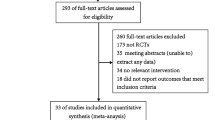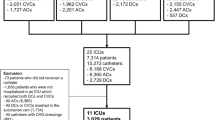Abstract
Purpose
The purpose of our study is to carry out a Bayesian network meta-analysis comparing the efficacy of different antimicrobial lock solutions (ALS) for prevention of catheter-related infections (CRI) in patients with hemodialysis (HD) and ranking these ALS for practical consideration.
Methods
We searched six electronic databases, earlier relevant meta-analysis and reference lists of included studies for randomized controlled trials (RCTs) that compared ALS for preventing episodes of CRI in patients with HD either head-to-head or against control interventions using non-ALS. Two authors independently assessed the methodological quality of included studies using the Cochrane risk of bias tool and extracted relevant information according to a predesigned extraction form. Data were analysed using the WinBUGS (V.1.4.3) and the Stata (V.13.0).
Results
Finally, 18 studies involving 2395 patients and evaluating 9 ALS strategies were included. Network meta-analysis showed that gentamicin plus citrate (OR 0.07, 95% CrI 0.00–0.48) and gentamicin plus heparin (OR 0.04, 95% CrI 0.00–0.23) were statistically superior to heparin alone in terms of reducing CRBSI. For exit site infection and all-cause mortality, no significant difference in the intervention effect (p > 0.05) was detected for all included ALS when compared to heparin. Moreover, all ALS were similar in efficacy (p > 0.05) from each other for CRBSI, exit site infection and all-cause mortality.
Conclusions
Our findings indicated that gentamicin plus heparin may be selected for the prophylaxis of CRI in patients undergoing HD with CVCs. Whether this strategy will lead to antimicrobial resistance remains unclear in view of the relatively short duration of included studies. More attentions should be made regarding head-to-head comparisons of the most commonly used ALS in this field.






Similar content being viewed by others
References
Rehman R, Schmidt RJ, Moss AH (2009) Ethical and legal obligation to avoid long-term tunneled catheter access. Clin J Am Soc Nephrol 4:456–460
Rayner HC, Besarab A, Brown WW et al (2004) Vascular access results from the Dialysis Outcomes and Practice Patterns Study (DOPPS): performance against Kidney Disease Outcomes Quality Initiative (K/DOQI) clinical practice guidelines. Am J Kidney Dis 44:22–26
Pisoni RL, Young EW, Dykstra DM et al (2002) Vascular access use in Europe and the United States: results from the DOPPS. Kidney Int 61:305–316
Lacson E Jr, Lazarus JM, Himmelfarb J et al (2007) Balancing fistula first with catheters last. Am J Kidney Dis 50:379–395
Taylor G, Gravel D, Johnston L et al (2002) Prospective surveillance for primary bloodstream infections occurring in Canadian hemodialysis units. Infect Control Hosp Epidemiol 23:716–720
Silva TN, de Marchi D, Mendes ML et al (2014) Approach to prophylactic measures for central venous catheter-related infections in hemodialysis: a critical review. Hemodial Int 18:15–23
Katneni R, Hedayati SS (2007) Central venous catheter-related bacteremia in chronic hemodialysis patients: epidemiology and evidence-based management. Nat Clin Pract Nephrol 3:256–266
Ishani A, Collins AJ, Herzog CA et al (2005) Septicemia, access and cardiovascular disease in dialysis patients: the USRDS Wave 2 study. Kidney Int 68:311–318
Engemann JJ, Friedman JY, Reed SD et al (2005) Clinical outcomes and costs due to Staphylococcus aureus bacteremia among patients receiving long-term hemodialysis. Infect Control Hosp Epidemiol 26:534–539
Costerton JW, Stewart PS, Greenberg EP (1999) Bacterial biofilms: a common cause of persistent infections. Science 284:1318–1322
Donlan RM (2001) Biofilm formation: a clinically relevant microbiologic process. Clin Infect Dis 33:1387–1392
Lewis K (2001) Riddle of biofilm resistance. Antimicrob Agents Chemother 45:999–1007
Dogra GK, Herson H, Hutchison B et al (2002) Prevention of tunneled hemodialysis catheter-related infections using catheter-restricted filling with gentamicin and citrate: a randomized controlled study. J Am Soc Nephrol 13:2133–2139
Betjes MG, van Agteren M (2004) Prevention of dialysis catheter-related sepsis with a citrate-taurolidine-containing lock solution. Nephrol Dial Transplant 19:1546–1551
Bleyer AJ, Mason L, Russell G et al (2005) A randomized, controlled trial of a new vascular catheter flush solution (minocycline-EDTA) in temporary hemodialysis access. Infect Control Hosp Epidemiol 26:520–524
Snaterse M, Rüger W, Scholte Op Reimer WJ et al (2010) Antibiotic-based catheter lock solutions for prevention of catheter-related bloodstream infection: a systematic review of randomised controlled trials. J Hosp Infect 75:1–11
Rabindranath KS, Bansal T, Adams J et al (2009) Systematic review of antimicrobials for the prevention of hemodialysis catheter-related infections. Nephrol Dial Transplant 24:3763–3774
Yahav D, Rozen-Zvi B, Gafter-Gvili A et al (2008) Antimicrobial lock solutions for the prevention of infections associated with intravascular catheters in patients undergoing hemodialysis: systematic review and meta-analysis of randomized, controlled trials. Clin Infect Dis 47:83–93
Liu H, Liu H, Deng J et al (2014) Preventing catheter-related bacteremia with taurolidine-citrate catheter locks: a systematic review and meta-analysis. Blood Purif 37:179–187
Zhao Y, Li Z, Zhang L et al (2014) Citrate versus heparin lock for hemodialysis catheters: a systematic review and meta-analysis of randomized controlled trials. Am J Kidney Dis 63:479–490
Lu G, Ades AE (2004) Combination of direct and indirect evidence in mixed treatment comparisons. Stat Med 23:3105–3124
Jansen JP, Crawford B, Bergman G et al (2008) Bayesian meta-analysis of multiple treatment comparisons: an introduction to mixed treatment comparisons. Value Health 11:956–964
Catalá-López F, Tobías A, Cameron C et al (2014) Network meta-analysis for comparing treatment effects of multiple interventions: an introduction. Rheumatol Int 34:1489–1496
O’Grady NP, Alexander M, Dellinger EP et al (2002) Guidelines for the prevention of intravascular catheter-related infections. Centers for Disease Control and Prevention. MMWR Recomm Rep 51:1–29
Higgins JP, Altman DG, Gøtzsche PC et al (2011) The Cochrane Collaboration’s tool for assessing risk of bias in randomised trials. BMJ 343:d5928
Shriner D, Yi N (2009) Deviance information criterion (DIC) in Bayesian multiple QTL mapping. Comput Stat Data Anal 53:1850–1860
Brooks SP, Gelman A (1998) General methods for monitoring convergence of iterative simulations. J Comput Graph Stat 7:434–445
McIntyre CW, Hulme LJ, Taal M et al (2004) Locking of tunneled hemodialysis catheters with gentamicin and heparin. Kidney Int 66:801–805
Saxena AK, Panhotra BR (2005) The impact of catheter-restricted filling with cefotaxime and heparin on the lifespan of temporary hemodialysis catheters: a case controlled study. J Nephrol 18:755–763
Weijmer MC, van den Dorpel MA, Van de Ven PJ et al (2005) Randomized, clinical trial comparison of trisodium citrate 30% and heparin as catheter-locking solution in hemodialysis patients. J Am Soc Nephrol 16:2769–2777
Nori US, Manoharan A, Yee J et al (2006) Comparison of low-dose gentamicin with minocycline as catheter lock solutions in the prevention of catheter-related bacteremia. Am J Kidney Dis 48:596–605
Macrae JM, Dojcinovic I, Djurdjev O et al (2009) Citrate 4% versus heparin and the reduction of thrombosis study (CHARTS). Clin J Am Soc Nephrol 3:369–374
Tan HZ (2008) A randomized controlled study on prevention of catheter-related bacteremia with gentamicin-heparin lock solution. Dissertation, Zhejiang University
Zhang P, Yuan J, Tan H et al (2009) Successful prevention of cuffed hemodialysis catheter-related infection using an antibiotic lock technique by strictly catheter-restricted antibiotic lock solution method. Blood Purif 27:206–211
Solomon LR, Cheesbrough JS, Ebah L et al (2010) A randomized double-blind controlled trial of taurolidine-citrate catheter locks for the prevention of bacteremia in patients treated with hemodialysis. Am J Kidney Dis 55:1060–1068
Campos RP, do Nascimento MM, Chula DC et al (2011) Minocycline-EDTA lock solution prevents catheter-related bacteremia in hemodialysis. J Am Soc Nephrol 22:1939–1945
Filiopoulos V, Hadjiyannakos D, Koutis I et al (2011) Approaches to prolong the use of uncuffed hemodialysis catheters: results of a randomized trial. Am J Nephrol 33:260–268
Lu DS (2011) Gentamicin lock solution prevents central venous catheter-related infections in hemodialysis. Med Inform 24:123–124
Broom JK, Krishnasamy R, Hawley CM et al (2012) A randomised controlled trial of heparin versus ethanol lock therapy for the prevention of catheter associated infection in hemodialysis patients–the HEALTHY-CATH trial. BMC Nephrol 13:146
Moran J, Sun S, Khababa I et al (2012) A randomized trial comparing gentamicin/citrate and heparin locks for central venous catheters in maintenance hemodialysis patients. Am J Kidney Dis 59:102–107
Sofroniadou S, Revela I, Smirloglou D et al (2012) Linezolid versus vancomycin antibiotic lock solution for the prevention of nontunneled catheter-related blood stream infections in hemodialysis patients: a prospective randomized study. Semin Dial 25:344–350
Hu ZX, Xiao HQ, Fei P (2013) Application of the lock solution containing l% cefazolin/30% sodium citrate for long-term indwelling catheters in maintenance hemodialysis patient. Chin J Blood Purif 12:602–604
Zacharioudakis IM, Zervou FN, Arvanitis M et al (2014) Antimicrobial lock solutions as a method to prevent central line-associated bloodstream infections: a meta-analysis of randomized controlled trials. Clin Infect Dis 59:1741–1749
Oliver MJ, Callery SM, Thorpe KE et al (2000) Risk of bacteremia from temporary hemodialysis catheters by site of insertion and duration of use: a prospective study. Kidney Int 58:2543–2545
Wang AY, Ivany JN, Perkovic V et al (2013) Anticoagulant therapies for the prevention of intravascular catheters malfunction in patients undergoing hemodialysis: systematic review and meta-analysis of randomized, controlled trials. Nephrol Dial Transplant 28:2875–2888
Landry DL, Braden GL, Gobeille SL et al (2010) Emergence of gentamicin-resistant bacteremia in hemodialysis patients receiving gentamicin lock catheter prophylaxis. Clin J Am Soc Nephrol 5:1799–1804
Funding
This research received no specific grant from any funding agency in the public, commercial or not-for-profit sectors.
Author information
Authors and Affiliations
Corresponding authors
Ethics declarations
Conflict of interest
The authors declare that there are no conflicts of interest.
Ethical approval
This article does not contain any studies with human participants or animals performed by any of the authors.
Informed consent
For this type of study formal consent is not required.
Electronic supplementary material
Below is the link to the electronic supplementary material.
Rights and permissions
About this article
Cite this article
Zhang, J., Wang, B., Li, R. et al. Does antimicrobial lock solution reduce catheter-related infections in hemodialysis patients with central venous catheters? A Bayesian network meta-analysis. Int Urol Nephrol 49, 701–716 (2017). https://doi.org/10.1007/s11255-016-1490-x
Received:
Accepted:
Published:
Issue Date:
DOI: https://doi.org/10.1007/s11255-016-1490-x




